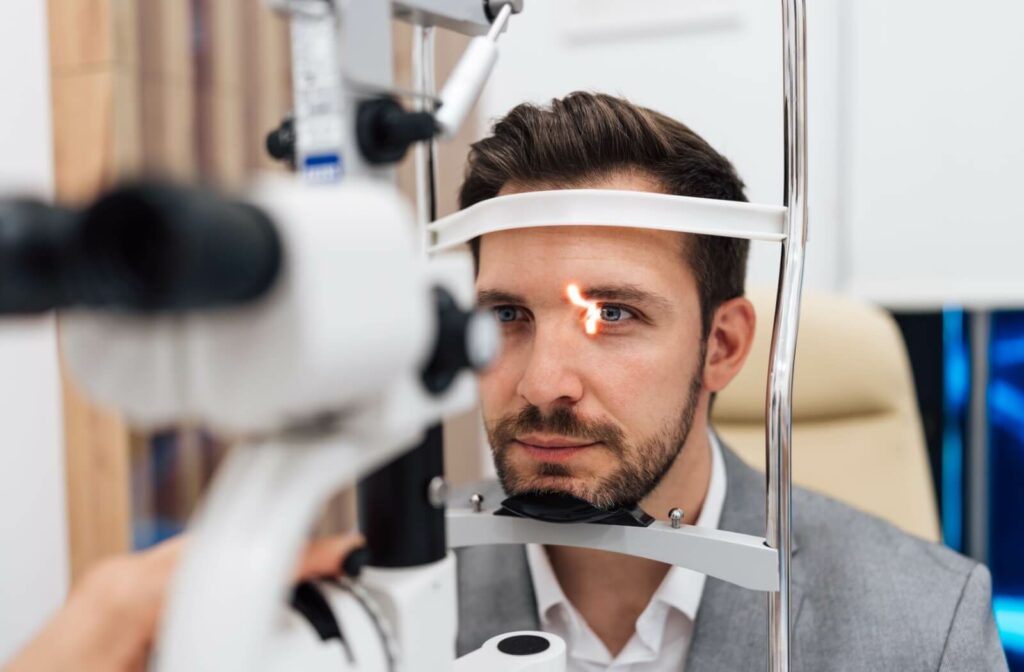When we think of vision care, glasses, contacts, and eye exams often come to mind. But for many people with functional vision problems or neurological issues affecting their sight, traditional approaches may not be enough. That’s where Syntonic phototherapy comes in—a time-tested, noninvasive therapy that uses the power of light to help restore balance to the visual system and the brain.
Whether you’re navigating vision challenges yourself or seeking alternative treatments for a loved one, understanding Syntonics could open the door to new possibilities.
Defining Syntonic Phototherapy
Syntonic phototherapy, also called optometric phototherapy, is a form of light therapy that has been used in clinical settings for over 70 years. It involves exposing the eyes to specific frequencies and wavelengths of coloured light to stimulate certain areas of the brain and balance the autonomic nervous system.
Unlike full-body light therapy used for seasonal affective disorder (SAD), Syntonic therapy focuses light directly into the eyes using coloured filter goggles and a precisely calibrated light source. These treatments are short—usually around 10 minutes per session—but they can have a lasting impact on both vision and overall neurological function.
How Does Syntonic Phototherapy Work?
When light enters the eye, it does more than just help us see—it travels through the visual system to the brain, impacting areas like the pineal gland and hypothalamus. These regions are responsible for regulating hormones, circadian rhythms, and the autonomic nervous system, which controls many involuntary functions, including pupil size, heart rate, and digestion.
In Syntonic therapy, different-coloured lights stimulate either the sympathetic (“fight or flight”) or parasympathetic (“rest and digest”) nervous systems. The goal is to restore balance between these two branches for better overall function.
Here’s how the colours are used:
- Blue and violet tones stimulate the parasympathetic system, reducing stress and adrenaline production. These colours are often used to help with near vision focusing, anxiety, and visual fatigue.
- Red, orange, and yellow tones stimulate the sympathetic system, improving alertness and enhancing visual clarity. These are commonly used in the treatment of amblyopia (lazy eye), strabismus (eye turn), and other developmental vision disorders.
- Green and yellow can help with eye alignment issues, such as esotropia (an inward-turning eye), by targeting specific neurological pathways.
What Conditions Can It Help With?
Syntonic phototherapy is typically used as part of a larger vision therapy program. It’s not a cure-all, but it can enhance other treatments like eye exercises, specialty lenses, and prism correction. Studies and clinical observations suggest that Syntonic therapy can be effective in managing:
- Amblyopia
- Strabismus
- Convergence insufficiency
- Focusing difficulties
- Visual attention problems
- Light sensitivity
- Post-concussion visual symptoms
- Headaches and migraines
- Learning challenges linked to visual processing
- Traumatic brain injuries
In many of these cases, light therapy helps improve visual efficiency, reduce eye strain, and support the brain’s ability to adapt and rewire itself—a concept known as neuroplasticity.

What Are the Benefits of Syntonic Phototherapy?
Patients and practitioners report a wide range of benefits from Syntonic phototherapy, especially when integrated with a personalized vision therapy plan. These include:
- Improved visual acuity: Some patients experience clearer vision, particularly when combined with other treatments.
- Increased visual attention and focus: Syntonic therapy can help boost concentration and reduce visual fatigue during tasks like reading and computer work.
- Reduced eye strain and headaches: By balancing the nervous system, light therapy may relieve symptoms triggered by screen time or stress.
- Better balance between brain hemispheres: Light stimulation may promote greater integration between the left and right brain, improving learning and processing speed.
- Decreased light sensitivity: Many patients with concussion, migraines, or sensory processing disorders report reduced discomfort in bright environments after therapy.
- Enhanced emotional regulation: Because it targets the hypothalamus and pineal gland, Syntonic therapy may also have mood-stabilizing effects.
What to Expect from a Syntonic Therapy Session
Syntonic sessions are brief and comfortable. You’ll sit in a dimly lit room and wear a pair of coloured filter goggles while looking into a light device for about 10 minutes. The colour chosen depends on your specific diagnosis and treatment goals.
Most therapy programs include multiple sessions over several weeks, which are often combined with other treatments. Because it’s a gentle, noninvasive therapy, it’s well tolerated by both children and adults.
Is Syntonic Phototherapy Right for You?
If you’re struggling with a vision condition that doesn’t respond fully to glasses or contacts, or you’ve experienced visual symptoms after a concussion or brain injury, Syntonic phototherapy may be worth exploring. While it isn’t meant to replace traditional eye care, it can be a valuable complement to it, particularly for neurological and functional vision concerns.
At Milton Vision & Sports Vision Training Centre, we offer comprehensive vision therapy programs tailored to your needs, including Syntonic phototherapy. Our team uses evidence-based techniques to help you or your child achieve optimal visual performance—whether in the classroom, on the playing field, or in everyday life.
Contact us today to book a consultation and see if light therapy could be a bright step forward.



